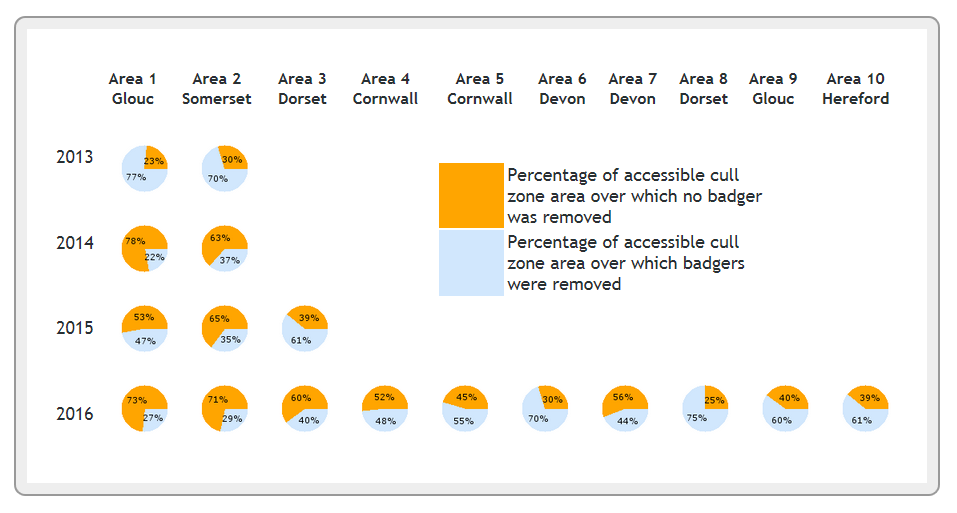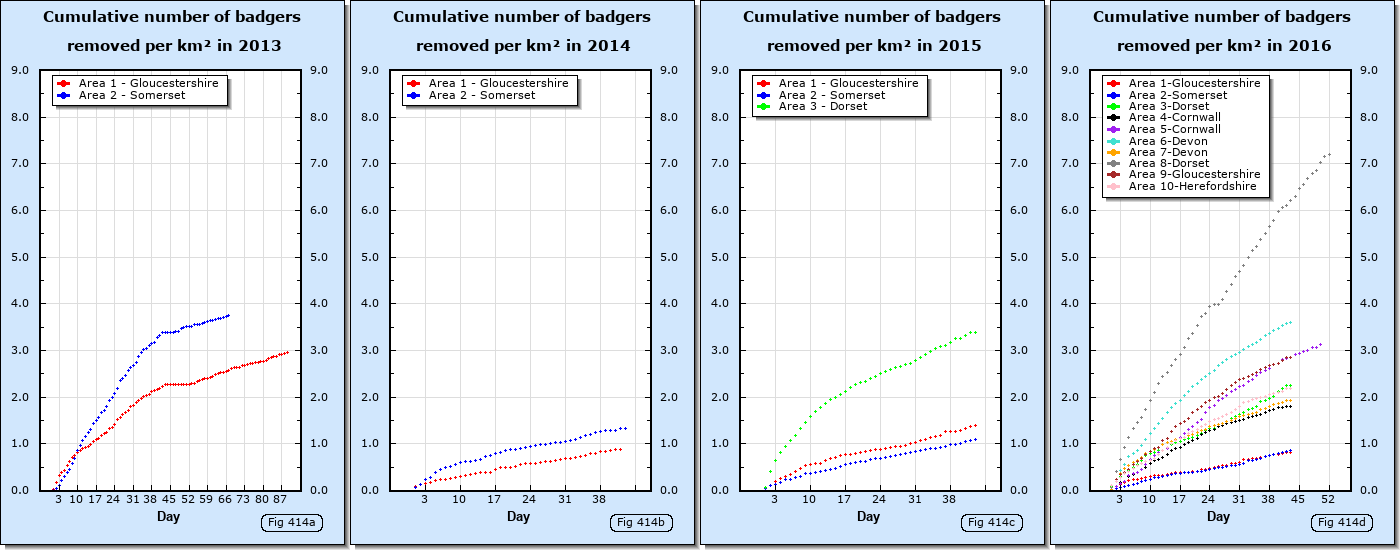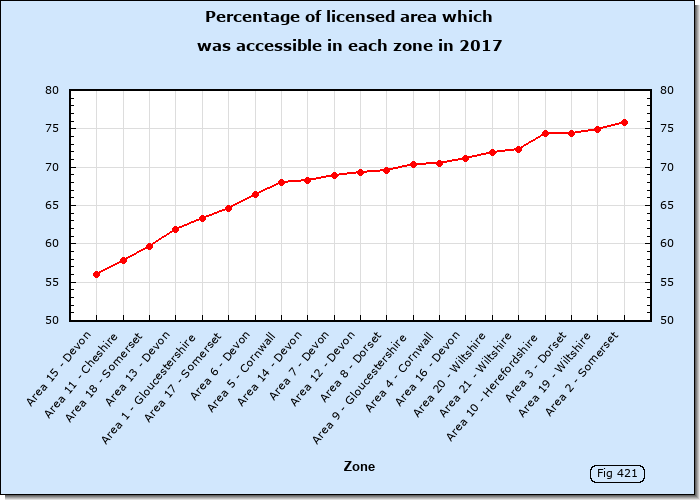Badger cull thoroughness
Summary
Between 2013 and 2016 collected records show that the area of participant's land parcels in which no badgers were removed
was half (actually 49.5%) of the accessible area across the badger cull zones. In Gloucestershire this percentage exceeded 75% in 2014 and
was just less than 75% in 2016. This was found from information supplied by Natural England and is based on records submitted at badger collection points by those performing the culls.
The data
Data was requested from Natural England on 13th September 2017 under Freedom of Information Request RFI 4007. The request can be viewed by
clicking
here.
The above request refers to polygons. Natural England defined a polygon as follows on 21st
October 2016
in response to a request for clarification.
When we are supplied with the information on a dispatched badger the location information we receive relates to the participant who's land the badger was dispatched on. Participant land is mapped as a block of land, which in GIS mapping is called a polygon. So for example if we receive information that a badger has been dispatched on the P456's land, then we allocate that dispatched badger to the polygon belonging to P456. We will not have the precise location via say a Grid Reference. All we know is that the dispatching took place somewhere in that polygon.
On 8th November 2017 Natural England sent the data shown in the following links.
- RFI 4007 Response to Customer 081117.
- RFI 4007 Response to Customer Q1 Daily Returns 2013-2016 081117.
- RFI 4007 Response to Customer Q2&Q3 081117.
Illustration of the data received in RFI4007
The images below are thumbnails which may appear at a larger size if clicked.



| Year | Area | Number of badgers collected
but not included in the
count of badgers trapped/shot |
|---|
| 2013 | - | Information not held |
| 2014 | - | Information not held |
| 2015 | Area 1 - Gloucestershire | 1 |
| 2015 | Area 2 - Somerset | 1 |
| 2016 | Area 2 - Somerset | 4 |
Discussion of the above results
If only 65% of licensed areas are accessible and only half of accessible areas are having any badgers removed from
them then badgers are being removed from
only a third of licensed area. However removal of badgers from neighbouring land parcels may benefit these parcels
from which no badgers were removed.
Comparison with RBCT

In terms of the number of badgers removed per square kilometre, cull rates in these culls are comparable to those in the RBCT.
Please refer to the tables below for References. Clicking on the links will take you directly to the correct page in these references.
Badgers removed in the RBCT reactive culls
| Year | Zone | Cull type | Number of badgers removed | Treatment area (km2) | Badgers removed per km2 | References |
|---|
| 1999 | b | reactive | 73 | 96.8 | 0.75 | Table_2.6_of_Ref_4,Appendix_D_of_Ref_4 |
| 2000 | a | reactive | 34 | 112.5 | 0.30 | Table_2.6_of_Ref_4,Appendix_D_of_Ref_4 |
| 2000 | b | reactive | 34 | 96.8 | 0.35 | Table_2.6_of_Ref_4,Appendix_D_of_Ref_4 |
| 2000 | c | reactive | 179 | 120.6 | 1.48 | Table_2.6_of_Ref_4,Appendix_D_of_Ref_4 |
| 2002 | a | reactive | 47 | 112.5 | 0.42 | Table_2.6_of_Ref_4,Appendix_D_of_Ref_4 |
| 2002 | b | reactive | 84 | 96.8 | 0.87 | Table_2.6_of_Ref_4,Appendix_D_of_Ref_4 |
| 2002 | c | reactive | 115 | 120.6 | 0.95 | Table_2.6_of_Ref_4,Appendix_D_of_Ref_4 |
| 2002 | e | reactive | 62 | 108.6 | 0.57 | Table_2.6_of_Ref_4,Appendix_D_of_Ref_4 |
| 2002 | f | reactive | 145 | 113.9 | 1.27 | Table_2.6_of_Ref_4,Appendix_D_of_Ref_4 |
| 2002 | g | reactive | 171 | 115.7 | 1.48 | Table_2.6_of_Ref_4,Appendix_D_of_Ref_4 |
| 2002 | h | reactive | 17 | 123.6 | 0.14 | Table_2.6_of_Ref_4,Appendix_D_of_Ref_4 |
| 2003 | a | reactive | 36 | 112.5 | 0.32 | Table_2.6_of_Ref_4,Appendix_D_of_Ref_4 |
| 2003 | b | reactive | 110 | 96.8 | 1.14 | Table_2.6_of_Ref_4,Appendix_D_of_Ref_4 |
| 2003 | c | reactive | 101 | 120.6 | 0.84 | Table_2.6_of_Ref_4,Appendix_D_of_Ref_4 |
| 2003 | d | reactive | 122 | 115.2 | 1.06 | Table_2.6_of_Ref_4,Appendix_D_of_Ref_4 |
| 2003 | e | reactive | 125 | 108.6 | 1.15 | Table_2.6_of_Ref_4,Appendix_D_of_Ref_4 |
| 2003 | f | reactive | 291 | 113.9 | 2.55 | Table_2.6_of_Ref_4,Appendix_D_of_Ref_4 |
| 2003 | g | reactive | 84 | 115.7 | 0.73 | Table_2.6_of_Ref_4,Appendix_D_of_Ref_4 |
| 2003 | h | reactive | 143 | 123.6 | 1.16 | Table_2.6_of_Ref_4,Appendix_D_of_Ref_4 |
| 2003 | i | reactive | 94 | 137.6 | 0.68 | Table_2.6_of_Ref_4,Appendix_D_of_Ref_4 |
Badgers removed in the RBCT proactive culls
| Year | Zone | Cull type | Number of badgers removed | Treatment area (km2) | Badgers removed per km2 | References |
|---|
| 1998 | b | proactive | 238 | 101.8 | 2.34 | Page_10_of_Ref_2,Table_2.4_of_Ref_4,Appendix_D_of_Ref_4 |
| 1999 | a | proactive | 55 | 103.8 | 0.53 | Page_10_of_Ref_2,Table_2.4_of_Ref_4,Appendix_D_of_Ref_4 |
| 1999 | b | proactive | 83 | 101.8 | 0.82 | Page_10_of_Ref_2,Table_2.4_of_Ref_4,Appendix_D_of_Ref_4 |
| 1999 | c | proactive | 244 | 121.2 | 2.01 | Page_10_of_Ref_2,Table_2.4_of_Ref_4,Appendix_D_of_Ref_4 |
| 2000 | b | proactive | 74 | 101.8 | 0.73 | Page_10_of_Ref_2,Table_2.4_of_Ref_4,Appendix_D_of_Ref_4 |
| 2000 | c | proactive | 111 | 121.2 | 0.92 | Page_10_of_Ref_2,Table_2.4_of_Ref_4,Appendix_D_of_Ref_4 |
| 2000 | e | proactive | 747 | 118.8 | 6.29 | Page_10_of_Ref_2,Table_2.4_of_Ref_4,Appendix_D_of_Ref_4 |
| 2000 | f | proactive | 452 | 110.8 | 4.08 | Page_10_of_Ref_2,Table_2.4_of_Ref_4,Appendix_D_of_Ref_4 |
| 2000 | g | proactive | 426 | 114 | 3.74 | Page_10_of_Ref_2,Table_2.4_of_Ref_4,Appendix_D_of_Ref_4 |
| 2000 | h | proactive | 162 | 116 | 1.40 | Page_10_of_Ref_2,Table_2.4_of_Ref_4,Appendix_D_of_Ref_4 |
| 2002 | a | proactive | 146 | 103.8 | 1.41 | Page_10_of_Ref_2,Table_2.4_of_Ref_4,Appendix_D_of_Ref_4 |
| 2002 | b | proactive | 49 | 101.8 | 0.48 | Page_10_of_Ref_2,Table_2.4_of_Ref_4,Appendix_D_of_Ref_4 |
| 2002 | c | proactive | 126 | 121.2 | 1.04 | Page_10_of_Ref_2,Table_2.4_of_Ref_4,Appendix_D_of_Ref_4 |
| 2002 | d | proactive | 292 | 104.1 | 2.80 | Page_10_of_Ref_2,Table_2.4_of_Ref_4,Appendix_D_of_Ref_4 |
| 2002 | e | proactive | 96 | 118.8 | 0.81 | Page_10_of_Ref_2,Table_2.4_of_Ref_4,Appendix_D_of_Ref_4 |
| 2002 | f | proactive | 249 | 110.8 | 2.25 | Page_10_of_Ref_2,Table_2.4_of_Ref_4,Appendix_D_of_Ref_4 |
| 2002 | g | proactive | 204 | 114 | 1.79 | Page_10_of_Ref_2,Table_2.4_of_Ref_4,Appendix_D_of_Ref_4 |
| 2002 | h | proactive | 231 | 116 | 1.99 | Page_10_of_Ref_2,Table_2.4_of_Ref_4,Appendix_D_of_Ref_4 |
| 2002 | i | proactive | 218 | 131.4 | 1.66 | Page_10_of_Ref_2,Table_2.4_of_Ref_4,Appendix_D_of_Ref_4 |
| 2002 | j | proactive | 442 | 110.5 | 4.00 | Page_10_of_Ref_2,Table_2.4_of_Ref_4,Appendix_D_of_Ref_4 |
| 2003 | a | proactive | 52 | 103.8 | 0.50 | Page_10_of_Ref_2,Table_2.4_of_Ref_4,Appendix_D_of_Ref_4 |
| 2003 | b | proactive | 170 | 101.8 | 1.67 | Page_10_of_Ref_2,Table_2.4_of_Ref_4,Appendix_D_of_Ref_4 |
| 2003 | c | proactive | 132 | 121.2 | 1.09 | Page_10_of_Ref_2,Table_2.4_of_Ref_4,Appendix_D_of_Ref_4 |
| 2003 | d | proactive | 369 | 104.1 | 3.54 | Page_10_of_Ref_2,Table_2.4_of_Ref_4,Appendix_D_of_Ref_4 |
| 2003 | e | proactive | 258 | 118.8 | 2.17 | Page_10_of_Ref_2,Table_2.4_of_Ref_4,Appendix_D_of_Ref_4 |
| 2003 | f | proactive | 103 | 110.8 | 0.93 | Page_10_of_Ref_2,Table_2.4_of_Ref_4,Appendix_D_of_Ref_4 |
| 2003 | g | proactive | 144 | 114 | 1.26 | Page_10_of_Ref_2,Table_2.4_of_Ref_4,Appendix_D_of_Ref_4 |
| 2003 | h | proactive | 71 | 116 | 0.61 | Page_10_of_Ref_2,Table_2.4_of_Ref_4,Appendix_D_of_Ref_4 |
| 2003 | i | proactive | 176 | 131.4 | 1.34 | Page_10_of_Ref_2,Table_2.4_of_Ref_4,Appendix_D_of_Ref_4 |
| 2003 | j | proactive | 185 | 110.5 | 1.67 | Page_10_of_Ref_2,Table_2.4_of_Ref_4,Appendix_D_of_Ref_4 |
| 2004 | a | proactive | 58 | 103.8 | 0.56 | Page_10_of_Ref_2,Table_2.4_of_Ref_4,Appendix_D_of_Ref_4 |
| 2004 | b | proactive | 111 | 101.8 | 1.09 | Page_10_of_Ref_2,Table_2.4_of_Ref_4,Appendix_D_of_Ref_4 |
| 2004 | c | proactive | 187 | 121.2 | 1.54 | Page_10_of_Ref_2,Table_2.4_of_Ref_4,Appendix_D_of_Ref_4 |
| 2004 | d | proactive | 211 | 104.1 | 2.03 | Page_10_of_Ref_2,Table_2.4_of_Ref_4,Appendix_D_of_Ref_4 |
| 2004 | e | proactive | 214 | 118.8 | 1.80 | Page_10_of_Ref_2,Table_2.4_of_Ref_4,Appendix_D_of_Ref_4 |
| 2004 | f | proactive | 220 | 110.8 | 1.99 | Page_10_of_Ref_2,Table_2.4_of_Ref_4,Appendix_D_of_Ref_4 |
| 2004 | g | proactive | 103 | 114 | 0.90 | Page_10_of_Ref_2,Table_2.4_of_Ref_4,Appendix_D_of_Ref_4 |
| 2004 | h | proactive | 75 | 116 | 0.65 | Page_10_of_Ref_2,Table_2.4_of_Ref_4,Appendix_D_of_Ref_4 |
| 2004 | i | proactive | 93 | 131.4 | 0.71 | Page_10_of_Ref_2,Table_2.4_of_Ref_4,Appendix_D_of_Ref_4 |
| 2004 | j | proactive | 109 | 110.5 | 0.99 | Page_10_of_Ref_2,Table_2.4_of_Ref_4,Appendix_D_of_Ref_4 |
| 2005 | a | proactive | 48 | 103.8 | 0.46 | Page_10_of_Ref_2,Table_2.4_of_Ref_4,Appendix_D_of_Ref_4 |
| 2005 | b | proactive | 58 | 101.8 | 0.57 | Page_10_of_Ref_2,Table_2.4_of_Ref_4,Appendix_D_of_Ref_4 |
| 2005 | c | proactive | 163 | 121.2 | 1.34 | Page_10_of_Ref_2,Table_2.4_of_Ref_4,Appendix_D_of_Ref_4 |
| 2005 | d | proactive | 182 | 104.1 | 1.75 | Page_10_of_Ref_2,Table_2.4_of_Ref_4,Appendix_D_of_Ref_4 |
| 2005 | e | proactive | 148 | 118.8 | 1.25 | Page_10_of_Ref_2,Table_2.4_of_Ref_4,Appendix_D_of_Ref_4 |
| 2005 | f | proactive | 155 | 110.8 | 1.40 | Page_10_of_Ref_2,Table_2.4_of_Ref_4,Appendix_D_of_Ref_4 |
| 2005 | g | proactive | 117 | 114 | 1.03 | Page_10_of_Ref_2,Table_2.4_of_Ref_4,Appendix_D_of_Ref_4 |
| 2005 | h | proactive | 53 | 116 | 0.46 | Page_10_of_Ref_2,Table_2.4_of_Ref_4,Appendix_D_of_Ref_4 |
| 2005 | i | proactive | 173 | 131.4 | 1.32 | Page_10_of_Ref_2,Table_2.4_of_Ref_4,Appendix_D_of_Ref_4 |
| 2005 | j | proactive | 109 | 110.5 | 0.99 | Page_10_of_Ref_2,Table_2.4_of_Ref_4,Appendix_D_of_Ref_4 |
Badgers removed in the culls which started in 2013
| Year | Zone | Number of badgers removed | Licensed area (km2) | Badgers removed per km2 | References |
|---|
| 2013 | gloucestershire_1 | 921 | 311 | 2.96 | Page_9_of_Ref_8,RFI4007_Sheet_Q3 |
| 2013 | somerset_2 | 940 | 256 | 3.67 | Page_9_of_Ref_8,RFI4007_Sheet_Q3 |
| 2014 | gloucestershire_1 | 274 | 311 | 0.88 | Page_1_of_Ref_3,RFI4007_Sheet_Q3 |
| 2014 | somerset_2 | 341 | 256 | 1.33 | Page_1_of_Ref_3,RFI4007_Sheet_Q3 |
| 2015 | gloucestershire_1 | 432 | 311 | 1.39 | Page_1_of_Ref_14,RFI4007_Sheet_Q3 |
| 2015 | somerset_2 | 279 | 256 | 1.09 | Page_1_of_Ref_14,RFI4007_Sheet_Q3 |
| 2015 | dorset_3 | 756 | 223 | 3.39 | Page_1_of_Ref_14,RFI4007_Sheet_Q3 |
| 2016 | gloucestershire_1 | 252 | 311 | 0.81 | Page_2_of_Ref_16,RFI4007_Sheet_Q3 |
| 2016 | somerset_2 | 217 | 256 | 0.85 | Page_2_of_Ref_16,RFI4007_Sheet_Q3 |
| 2016 | dorset_3 | 502 | 223 | 2.25 | Page_2_of_Ref_16,RFI4007_Sheet_Q3 |
| 2016 | cornwall_4 | 711 | 393 | 1.81 | Page_2_of_Ref_16,RFI4007_Sheet_Q3 |
| 2016 | cornwall_5 | 851 | 272 | 3.13 | Page_2_of_Ref_16,RFI4007_Sheet_Q3 |
| 2016 | devon_6 | 2038 | 567 | 3.59 | Page_2_of_Ref_16,RFI4007_Sheet_Q3 |
| 2016 | devon_7 | 833 | 431 | 1.93 | Page_2_of_Ref_16,RFI4007_Sheet_Q3 |
| 2016 | dorset_8 | 3000 | 417 | 7.19 | Page_2_of_Ref_16,RFI4007_Sheet_Q3 |
| 2016 | gloucestershire_9 | 1858 | 651 | 2.85 | Page_2_of_Ref_16,RFI4007_Sheet_Q3 |
| 2016 | herefordshire_10 | 624 | 285 | 2.19 | Page_2_of_Ref_16,RFI4007_Sheet_Q3 |
| 2017 | gloucestershire_1 | 172 | 311 | 0.55 | Page_2_of_Ref_17,RFI4007_Sheet_Q3 |
| 2017 | somerset_2 | 91 | 256 | 0.36 | Page_2_of_Ref_17,RFI4007_Sheet_Q3 |
| 2017 | dorset_3 | 257 | 223 | 1.15 | Page_2_of_Ref_17,RFI4007_Sheet_Q3 |
| 2017 | cornwall_4 | 213 | 393 | 0.54 | Page_2_of_Ref_17,RFI4007_Sheet_Q3 |
| 2017 | cornwall_5 | 358 | 272 | 1.32 | Page_2_of_Ref_17,RFI4007_Sheet_Q3 |
| 2017 | devon_6 | 727 | 567 | 1.28 | Page_2_of_Ref_17,RFI4007_Sheet_Q3 |
| 2017 | devon_7 | 246 | 431 | 0.57 | Page_2_of_Ref_17,RFI4007_Sheet_Q3 |
| 2017 | dorset_8 | 1166 | 430 | 2.71 | Page_2_of_Ref_17,RFI4007_Sheet_Q3 |
| 2017 | gloucestershire_9 | 1012 | 651 | 1.55 | Page_2_of_Ref_17,RFI4007_Sheet_Q3 |
| 2017 | herefordshire_10 | 394 | 285 | 1.38 | Page_2_of_Ref_17,RFI4007_Sheet_Q3 |
| 2017 | cheshire_11 | 736 | 292 | 2.52 | Page_2_of_Ref_17,RFI4007_Sheet_Q3 |
| 2017 | devon_12 | 1874 | 563 | 3.33 | Page_2_of_Ref_17,RFI4007_Sheet_Q3 |
| 2017 | devon_13 | 1237 | 432 | 2.86 | Page_2_of_Ref_17,RFI4007_Sheet_Q3 |
| 2017 | devon_14 | 708 | 249 | 2.84 | Page_2_of_Ref_17,RFI4007_Sheet_Q3 |
| 2017 | devon_15 | 763 | 207 | 3.69 | Page_2_of_Ref_17,RFI4007_Sheet_Q3 |
| 2017 | dorset_16 | 3450 | 1030 | 3.35 | Page_2_of_Ref_17,RFI4007_Sheet_Q3 |
| 2017 | somerset_17 | 1123 | 280 | 4.01 | Page_2_of_Ref_17,RFI4007_Sheet_Q3 |
| 2017 | somerset_18 | 489 | 198 | 2.47 | Page_2_of_Ref_17,RFI4007_Sheet_Q3 |
| 2017 | wiltshire_19 | 2252 | 623 | 3.61 | Page_2_of_Ref_17,RFI4007_Sheet_Q3 |
| 2017 | wiltshire_20 | 1040 | 546 | 1.90 | Page_2_of_Ref_17,RFI4007_Sheet_Q3 |
| 2017 | wiltshire_21 | 1229 | 332 | 3.70 | Page_2_of_Ref_17,RFI4007_Sheet_Q3 |
In the above tables treatment area in the RBCT means the same as licensed area in the 2013 culls.
It is the overall area which encompasses both accessible and inaccessible area.
Conclusions
According to records of land parcels on which badgers have been removed,
no badgers have been removed from approximately half of the accessible area and two thirds of licensed area in all zones each year.
If cull thoroughness is key, and these records are reliable, this does not bode well for TB control.
However, in terms of the number of badgers removed per square kilometre, cull rates between 2013 and 2017 were comparable to those achieved in the RBCT.
A note
History has shown that badger removal requires considerable persistence and dedication regardless of the method being
used. Cullers have only cage trapping and free shooting available to them for 6 weeks per year unless an extension is granted. This makes the task given to them
challenging particularly if they have the added burden of running a farm, managing a business or
going to work the next day.
References
- Monitoring the efficacy of badger population reduction by controlled shooting during the first six weeks of the pilots. AHVLA. Report to Defra. 31st January 2014.
- Association between Levels of TB in Cattle Herds and Badgers. C.A Donnelly and J Hone. 2010.
- Summary of badger control monitoring during 2014. DEFRA. December 2014.
- Final Report of the Independent Scientific Group on Cattle TB
- Pilot Badger Culls in Somerset and Gloucestershire. Report by the Independent Expert Panel. Chair: Professor Ranald Munro. Presented to DEFRA Secretary of State Owen Paterson MP, March 2014.
- The Government's policy on Bovine TB and badger control in England. DEFRA. December 2011.
- Badger culls and contractors hired. An email sent to nfu.org.uk on 18th Jan 2015.
- Badger Culling: Controlled Shooting Pilots. SN/SC/6837. E Ares. Last updated: 11 January 2015.
- Bovine TB: Distribution of effort in badger cull pilots Year 2. Reply from DEFRA to a FoI. ATIC0507. 21 January 2015.
- Estimating social group size of Eurasian badgers Meles meles by genotyping remotely plucked single hairs. LJ Thomas et al. Source: Wildlife Biology, 13(2):195-207. Published By: Nordic Board for Wildlife Research. 2007.
- Setting the minimum and maximum numbers for Year 2 of the badger culls. Advice to Natural England. Supplied by DEFRA. August 2014.
- Badger Cull Costs and Culled Badger Numbers. RFI 6456. DEFRA. 1st May 2014.
- Distribution of badger removals across the cull zones. FoI response from Natural England. RFI 2911. May 2015.
- Summary of badger control monitoring during 2014. DEFRA. December 2015.
- Setting the minimum and maximum numbers in Dorset for Year 1 of the badger cull. DEFRA. Advice to Natural England. August 2015.
- Summary of badger control monitoring during 2016. DEFRA. December 2016.
- Summary of badger control monitoring during 2017. DEFRA. December 2017.

